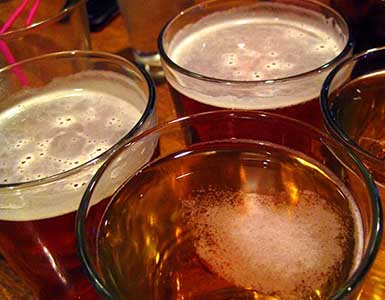Blog
Search
Blog
Ineffective State Alcohol Bills Popular in the U.S.
- Details
- Created: Tuesday, October 28 2014 11:53
A new study by University of Minnesota and Boston University researchers indicates that a majority of recently enacted U.S. state laws are politically popular, yet ineffective to address excessive drinking and alcohol-impaired driving.
Such laws, including requiring ignition interlocks for repeat DUI offenders and setting a minimum age for those selling and serving alcohol, are typically targeted at specific groups. They are favored by the alcohol industry because they don't significantly impact alcohol sales, and direct the blame for alcohol-related harm to individual drinkers rather than the alcohol industry itself.
The study found that, in large part because of the alcohol industry's lobbying clout, laws that enact evidence-based policies such as increased alcohol pricing, restrictions on alcohol advertising, and restrictions on alcohol access and availability are less likely to be proposed or passed. These policies target the population as a whole rather than specific groups, and have been deemed effective through a preponderance of peer-reviewed research.
The study's authors also note the dire consequences arising from the political inability to enact effective alcohol prevention policies: 88,000 deaths each year in the U.S., and $223.5 billion in economic harm.
3-Tier System Under Siege by AB InBev
- Details
- Created: Thursday, November 06 2014 08:57
Not only is AB InBev guzzling up craft brewers all over the country, they are also buying the related brewpubs, effectively removing the middle tier and setting themselves up as retailers as well. So much for the so-called protections of the 3-tier system.
AB InBev to Acquire Oregon Craft BrewerPurchase of 10 Barrel Brewing Is Company’s Latest Move to Tap U.S. Craft-Beer Industry
Wall Street Journal
By Mike Esterl
November 5, 2014
Anheuser-Busch InBev NV said Wednesday it is acquiring 10 Barrel Brewing Co., the latest move by the world’s largest brewer to tap the small but fast-growing U.S. craft-beer industry.
Bend, Ore.-based 10 Barrel expects to sell about 40,000 barrels of beer this year, according to AB InBev, which didn’t disclose financial details.
Annual U.S. beer consumption totals roughly 200 million barrels. Nearly half of that is brewed by Belgium’s AB InBev, whose globe-trotting brands include Budweiser, Corona and Stella Artois.
But big, mainstream brands have seen volumes slip in recent years as Americans drop mild-tasting lagers to experiment with India Pale Ale and other styles sold by smaller regional craft brewers. More than 300 such breweries opened their doors last year alone.
Sales of 10 Barrel have roughly doubled in the past year, according to a person familiar with the matter. Its top-selling beer is Apocalypse IPA, accounting for nearly half of its volume.
AB InBev announced in February it was acquiring Patchogue, N.Y.-based Blue Point Brewing Co., which sold about 60,000 barrels last year. It didn’t disclose financial terms of that deal, either, although some industry observers pegged the price tag at around $25 million.
The brewing giant also acquired Goose Island, Chicago’s largest craft brewer, in 2011 for $38.8 million.
Recent M&A deals have priced some regional U.S. craft brewers at more than $1,000 a barrel, according to a person familiar with multiples. The vast majority of the country’s roughly 3,000 craft brewers remain privately or family owned.
AB InBev said it expects to close its 10 Barrel acquisition by the end of 2014. In addition to buying the company’s brewery in Bend, it will also acquire 10 Barrel’s two existing brewpubs in Bend and Boise, Idaho, and a third brewpub scheduled to open in Portland, Ore. in early 2015.
First Beverage Group acted as financial adviser to 10 Barrel.

Read more & watch the CNN video: http://money.cnn.com/2014/11/06/news/companies/anheuser-busch-beer-10-barrel/
SF Giants: Pro Athletes or Ambassadors of Alcohol-Related Bad Behavior?
- Details
- Created: Thursday, October 23 2014 18:07
By Bruce Lee Livingston, Executive Director / CEO, Alcohol Justice

The most recent well-reported and inappropriate display of locker room excess followed the NL Pennant win. San Francisco Giant pitcher phenom, Madison Bumgarner, chugged four cans of Bud Light at once in the well-televised celebration late Thursday night. It was followed by SF Giant Sergio Romo’s abusive behavior towards his girlfriend outside a bar on Friday at 2:00 A.M. Romo’s allegedly alcohol-fueled domestic violence and disrespect to the SFPD was only reported on the following Monday.

It’s time for professional sports to take a major step back from its codependent relationship with Big Alcohol. While crazy lucrative for the companies involved it is intrinsically toxic to players and fans alike, especially underage youth who see their newfound heroes guzzling bubbles, suds and spirits on TV. It’s time for Sergio to focus on pitching baseballs instead of booze (P.S. Full disclosure, I love the guy for his “I Just Look Illegal T-Shirt” and I watched the whole game with my kids).

Baseball, please don’t act like football. Grow up and lose the booze and the domestic violence. Stop the locker room champagne and Bud Light celebrations.
More Articles ...
Subcategories
Help us hold Big Alcohol accountable for the harm its products cause.
| GET ACTION ALERTS AND eNEWS |
STAY CONNECTED    |
CONTACT US 24 Belvedere St. San Rafael, CA 94901 415-456-5692 |
SUPPORT US Terms of Service & Privacy Policy |
Copyright © 2025 Alcohol Justice. All Rights Reserved.
Joomla! is Free Software released under the GNU General Public License.



